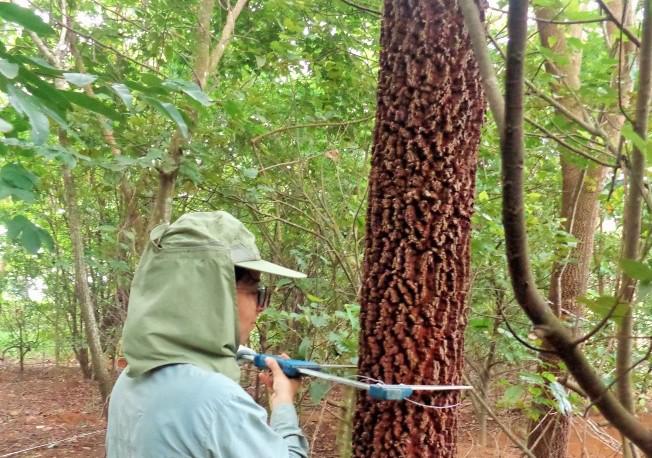Social media video featuring the project.
10 anos de Restauração no Xingu via semeadura direta
3 Mar 2017 Mato Grosso, Brazil, Central and Latin America Forests | Communities
This project aims to verify the success of the restoration of riparian forests at the headwaters of the Xingu river basin, in the state of Mato Grosso, Brazil.

Diameter wood sample of Anadenanthera macrocarpa planted by direct seeding nine years ago. Diameter is measured at 1.30 m from the soil.
Large-scale agriculture and cattle ranching are the main causes of deforestation in the Brazilian Amazon. The Amazon southern agricultural frontier is the region with the highest deforestation rate in Brazil. A total of 139,824 km2 of forest has been lost only in the state of Mato Grosso, which leads the national ranking of amount of deforested areas per state.
The Xingu River Basin, located in the transition zone between the Amazon and the Brazilian Cerrado, harbours a great socio-cultural and biological diversity. Headwaters in the Xingu Basin, in the state of Mato Grosso, have been heavily deforested, boosting the creation of the "Y Ikatu Xingu" program (Save Xingu’s good water, in Kamaiurá language), which conducts the restoration of these areas.
Each restoration project has specific objectives, but minimal human interference is a common strategy used by several projects, which renders the process cheaper and less labour-intensive. Direct seeding has been conducted in some tropical regions to restore forests. In this method, species are sown directly onto the soil, trying to simulate the process of natural regeneration. This method ensures germination and sapling establishment in natural local conditions, irregular spacing, and high densities.
Our study aims to verify the success of riparian forests restored via mechanized direct seeding at the headwaters of Xingu River. Notably, most studies that investigate the use of direct sowing with restoration purposes simply evaluate the early stages, such as seed germination and seedling survival. Our study will evaluate the trajectories and dynamics of areas in which the process of restoration is in progress. Moreover, we will also assess how abiotic factors, land use history, and sowing methods influence succession. These studies can provide subsidy to projects, and help in defining specific goals, guiding the adequate amount of seeds and number species per region, and help in lowering the costs and increasing the efficiency of ecological restoration.
Specific goals to this study are:
1) Evaluate the successional trajectories of plant community over 10 years;
2) Evaluate how the abiotic factors, history of land use, and the sowing method affect the structure and species composition of forests.
Social media video featuring the project.
10 anos de Restauração no Xingu via semeadura direta